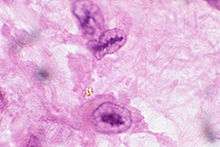Anitschkow cell

In pathology, Anitschkow (or Anichkov[1]) cells are often cells associated with rheumatic heart disease.[2] Anitschkow cells are enlarged macrophages found within granulomas (called Aschoff bodies) associated with the disease.[2]
The cells are also called caterpillar cells, as they have an ovoid nucleus and chromatin that is condensed toward the center of the nucleus in a wavy rod-like pattern that to some resembles a caterpillar.[2] Larger Anitschkow cells may coalesce to form multinucleated Aschoff giant cells.[2] Anitschkow cells were named after the Russian pathologist Nikolai Nikolajewitsch Anitschkow.[3]
Squamous epithelial cells with nuclear changes resembling Anitschkow cells have also been observed in recurrent aphthous stomatitis, iron deficiency anemia, children receiving chemotherapy, as well as in healthy individuals.[4][5]
References
- ↑ Rheumatic fever at eMedicine
- 1 2 3 4 Cotran, Ramzi S.; Kumar, Vinay; Fausto, Nelson; Robbins, Stanley L.; Abbas, Abul K. (2005). Robbins and Cotran pathologic basis of disease. St. Louis, MO: Elsevier Saunders. ISBN 0-7216-0187-1.
- ↑ Anitschkow's cell at Who Named It?
- ↑ Hine, Maynard K.; Shafer, William G. (1974). A textbook of oral pathology. Philadelphia: W.B.Saunders. ISBN 0-7216-2918-0.
- ↑ Wood TA, De Witt SH, Chu EW, Rabson AS, Graykowski EA (1975). "Anitschkow nuclear changes observed in oral smears". Acta Cytologica. 19 (5): 434–7. PMID 1058615.
